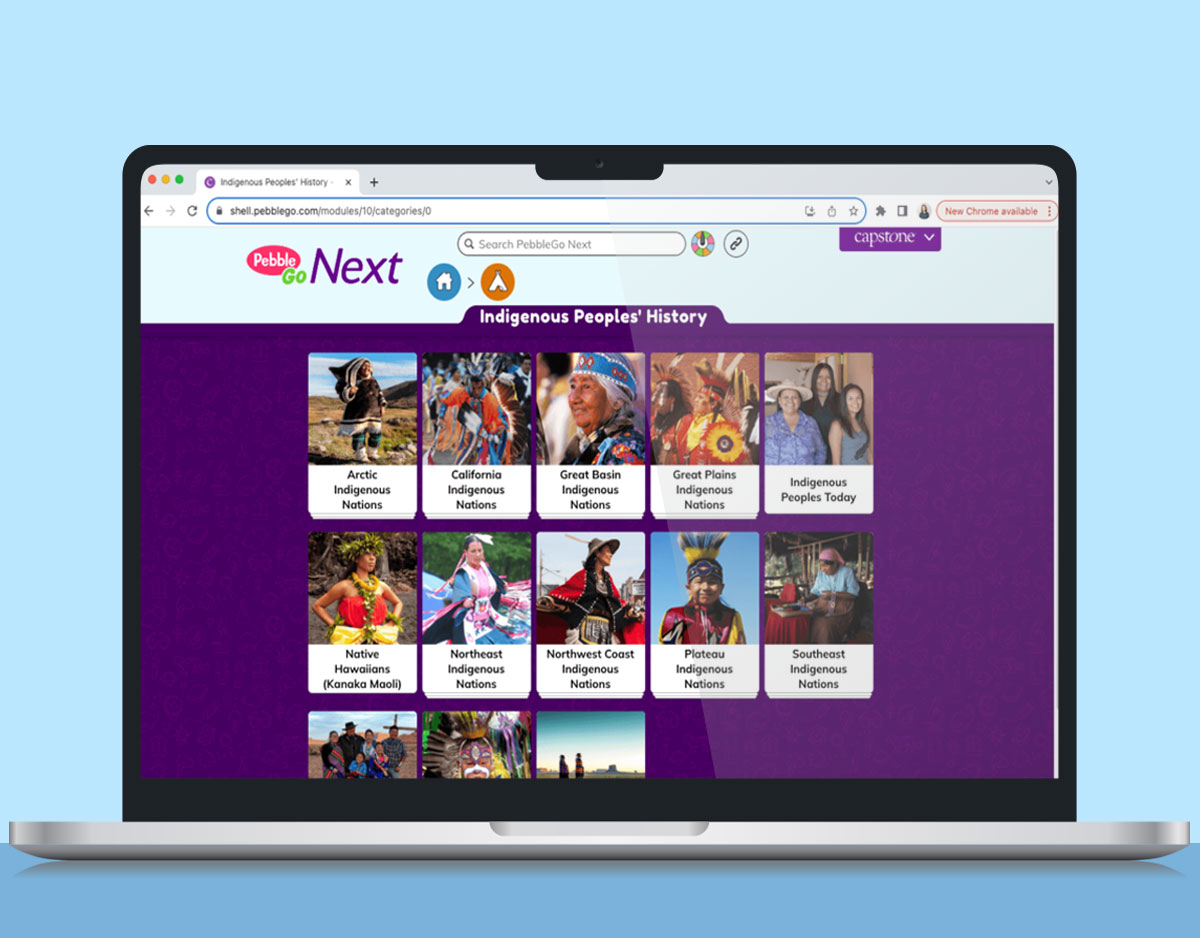SLJ Reviews PebbleGo Next's Indigenous Peoples’ History Database
This comprehensive digital resource provides accurate, thoughtful representation and digestible lessons on North American Indigenous nations.

URL shell.pebblego.com/modules/10categories
Grade level 3-5
Cost PebbleGo Next: Indigenous Peoples’ History is a subscription-based add-on, available through the Silver ($1,999) or Gold ($2,399) annual subscription package of PebbleGo. A quote can be requested at: pebblego.com/pricing.
Content This comprehensive digital resource provides accurate, thoughtful representation and digestible lessons on North American Indigenous nations. The module, housed within PebbleGo Next, features 13 sections dedicated to sharing the histories, traditions, and modern presence of Natives across North America. Some of these categories include Arctic Indigenous Nations, Great Basin Indigenous Nations, Indigenous Peoples Today, Northeast Indigenous Nations, and Tribal Sovereignty. Within each topic are several articles, one for each individual nation or for the broader region. For example, the Great Plains Indigenous Nations category lists nine Tribal Nations, such as the Arapaho, Blackfeet (Niisitapi), Osage, and Pawnee. Not all Tribal Nations have their own respective article within the categories. Some categories list one Tribal article, and that region’s piece discusses the different nations in that area. The broader Plateau Indigenous Nations article briefly describes the distinctions of the featured Tribes, including statements on the Umatilla, Yakama, Warm Springs, Confederated Salish and Kootenai Tribes, the Klamath, Cayuse, and Coeur d’Alene. The list includes the Tribes that are among the most known and largest of North American Nations and generally hold U.S. federal recognition status. At the end of each article, students are encouraged to connect this context to related content by navigating to other articles in the database. This often includes the respective state’s history.
Each article lesson features a “Critical Thinking Questions” handout activity with three questions where students can reflect and digest the content further into the context of the broader history or implications. Accompanying digital resources in each piece are short informational videos with a pop-out transcript, time line, citation tool for three styles (APA, MLA, and CMS), and a dictionary guide.
PebbleGo Next extends engagement through a gamified approach by including four games with background video game music, a random article spinner, and a “Question of the Day” poll. There are four game options, all using images and content from the articles. The first game is Jigsaw, where users complete a 3 x 3 image puzzle by rotating and putting pieces in the correct spot. The second game, more difficult than the previous, is Zoom, where users guess what is happening or shown in a zoomed-in image with multiple choice options. The third game is Wordscramble, in which users must choose letters to spell out the answer with help from a text hint and image. The final game is called Quick Match, in which players must answer prompts on whether the left vocabulary term card matches the right image card. These games are a fun, short way to gauge a student’s recall of mixed content. The background music option on the gamification features can toggle off to limit distraction or overstimulation.
Using the database’s guided search function is easy and generates predictions based on what users populate in the search bar, but may return applicable results system-wide of PebbleGo. For example, “Nava” predicts “Navajo” and “Navajo Code Talkers.” If users choose the latter, they will be taken to an “Important People in U.S. History” lesson in the Social Studies subject. An appreciated functional design for the breadcrumb trail, or a site’s navigational cues of a user’s current location online, is depicted in icon bubbles at the top of the page beneath the search bar. The displayed breadcrumbs will help users easily navigate through the database. For example, a related article in the “Southwest Indigenous Nations” is on “Texas.” From there, students will be transferred outside of the Indigenous Peoples’ History module to the “States” module. They would simply need to click the house icon to return to the main PebbleGo Next page and select “Indigenous Peoples’ History.” This allows students to explore related information and pertinent content outside of assigned curriculum when permitted.
Also important for accessibility, transcripts are included for each video, which feature natural voice audio from Indigenous voice actors. The lessons can be accessed on mobile devices, such as touch screen phones or tablets, promoting learning on the go or away from the classroom projector.
Student and Teachers The content enthusiastically engages with students and teachers alike. The lessons’ concise content can be used as supplement to curricula or as miniature lesson plans. The content supports young students in their development of worldviews and the origin stories of individual nations, with sovereignty as a foundation. It is clear that the development of articles was intentionally aligned with state and national standards.
Verdict The attractive layout and design of this database user interface makes this great for absorbing and comprehending the complex history and information of North American Tribal Nations. While the lessons do not wholly encompass all Tribal Nations, they provide a balanced beginning for gaining a deep understanding across multiple facets. This database is a valuable asset for extending the authentic depiction of Natives and their presence in the past and present with the functionality of context application across PebbleGo Next.
Kaitlin Srader (Diné/Navajo), Seattle, WA
RELATED
The job outlook in 2030: Librarians will be in demand
The job outlook in 2030: Librarians will be in demand
ALREADY A SUBSCRIBER? LOG IN
We are currently offering this content for free. Sign up now to activate your personal profile, where you can save articles for future viewing






Add Comment :-
Be the first reader to comment.
Comment Policy:
Comment should not be empty !!!